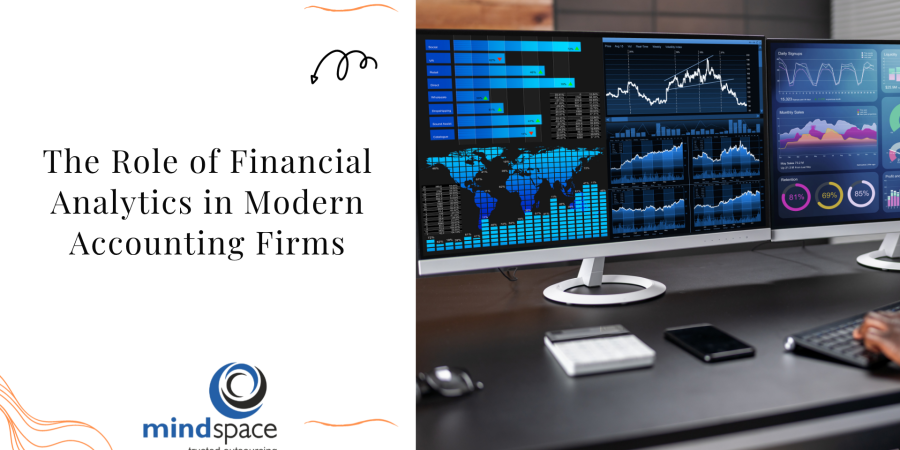The Role of Financial Analytics in Modern Accounting Firms
In today’s data-driven business landscape, accounting firms are no longer confined to traditional bookkeeping and tax preparation. Financial analytics has emerged as a game-changer, enabling firms to leverage large volumes of financial data to deliver deeper insights, enhance decision-making, and drive business growth.
By combining data analysis, statistical tools, and predictive modeling, financial analytics enables accounting firms to optimize performance, mitigate risks, and develop effective growth strategies for their clients. This article examines the significance of financial analytics in contemporary accounting firms and how it contributes to enhancing service offerings and client satisfaction.
What Is Financial Analytics?
Financial analytics is the process of collecting, processing, and analyzing financial data to provide actionable insights. Unlike traditional financial reporting, it utilizes advanced tools and techniques such as:
-
AI-powered forecasting
-
Machine learning algorithms
-
Real-time financial dashboards
Accounting firms use financial analytics to help clients understand:
-
Revenue trends
-
Cost structures
-
Cash flow patterns
-
Profitability metrics
By analyzing historical data and predicting future performance, firms can guide clients toward sustainable growth and financial stability.
Major Roles of Financial Analytics in Accounting Firms
1. Data-Driven Decision-Making for Clients
One of the primary benefits of financial analytics is the ability to improve decision-making. Real-time insights enable clients to make data-backed decisions instead of relying on intuition.
Example:
A retail business can leverage analytics to identify seasonal sales trends, optimize inventory, and allocate marketing budgets to maximize revenue.
2. Improved Cash Flow Management
Cash flow is the lifeline of any business. Poor cash management can lead to serious financial challenges. Financial analytics helps accounting firms:
-
Track inflows and outflows
-
Identify cash flow bottlenecks
-
Recommend actions to enhance liquidity
Using automated cash flow forecasting, firms can predict shortages and advise on solutions like adjusting payment terms or managing operational expenses effectively.
3. Profitability and Cost Optimization
Advanced analytics identifies profit drivers and cost leakages that impact a company’s bottom line.
Example:
For an e-commerce client, analytics can:
-
Track customer acquisition costs
-
Evaluate product category profitability
-
Suggest pricing adjustments to increase margins
4. Accurate Financial Forecasting and Budgeting
Traditional budgets rely heavily on historical data, which may not reflect dynamic market conditions. Financial analytics enables scenario modeling and predictive forecasting to plan strategically.
Example:
A manufacturing firm can forecast production costs, predict supply chain disruptions, and allocate resources efficiently using financial analytics.
5. Risk Management and Fraud Detection
Proactive risk assessment is critical for financial health. Financial analytics allows accounting firms to:
-
Detect potential financial risks
-
Monitor compliance
-
Identify fraud patterns
Machine learning can analyze transaction data to detect suspicious activities like unauthorized transactions or irregular expense claims.
6. Tax Strategy and Compliance
With constantly changing tax regulations, analytics empowers firms to optimize tax strategies and ensure compliance.
Example:
A multinational company can use financial analytics to:
-
Maximize tax credits
-
Identify deduction opportunities
-
Avoid penalties across multiple jurisdictions
7. Enhancing Client Advisory Services
Modern accounting firms are moving toward advisory-focused services. With financial analytics, firms can:
-
Provide industry-specific insights
-
Offer performance dashboards
-
Help clients track KPIs and achieve financial goals
Cloud-based platforms make real-time advisory services easier and more impactful.
8. Gaining Competitive Advantage
In today’s competitive market, firms that adopt financial analytics enjoy a significant edge. They can offer value-added services like:
-
Business intelligence reporting
-
Financial modeling
-
Automated analytics solutions
Example:
A firm managing short-term rental properties can use analytics to evaluate seasonal revenue trends, occupancy rates, and profitability, giving its clients an edge in the hospitality sector.
How Accounting Firms Can Implement Financial Analytics
To successfully implement financial analytics, accounting firms should follow these steps:
-
Invest in the Right Technology
Tools like Power BI, Tableau, QuickBooks Advanced Reporting, and Xero Analytics Plus are essential for generating actionable insights. -
Automate Data Collection
Streamline data collection from accounting software, bank feeds, CRMs, and ERP systems. -
Build a Data-Driven Culture
Train teams and clients on the importance of data-based financial decisions. -
Offer Customized Reporting
Provide industry-specific dashboards and insights tailored to client needs. -
Integrate AI and Machine Learning
Enhance predictive modeling, real-time analytics, and fraud detection capabilities.
Conclusion
Financial analytics is transforming modern accounting firms, turning them into strategic advisors rather than compliance-focused service providers. By leveraging data-driven insights, firms can:
-
Optimize cash flow
-
Improve profitability
-
Manage risks effectively
-
Guide clients toward long-term growth
Accounting firms that embrace financial analytics will stay ahead of the competition, deliver superior client service, and position themselves as trusted advisors in an increasingly digital financial world.


